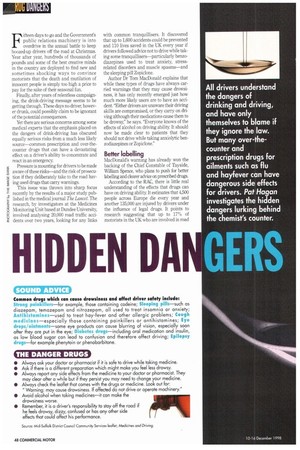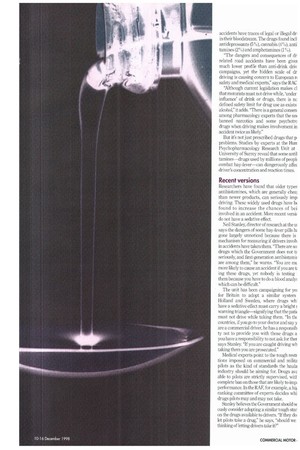F ifteen days to go and the Government's public relations machinery
Page 50

Page 51

If you've noticed an error in this article please click here to report it so we can fix it.
is into overdrive in the annual battle to keep boozed-up drivers off the road at Christmas. Year after year, hundreds of thousands of pounds and some of the best creative minds in the country are deployed to find new and sometimes shocking ways to convince motorists that the death and mutilation of innocent people is simply too high a price to pay for the sake of their seasonal fun.
Finally, after years of relentless campaigning, the drink-driving message seems to be getting through, These days no driver, however drunk, could possibly claim to be ignorant of the potential consequences.
Yet there are serious concerns among some medical experts that the emphasis placed on the dangers of drink-driving has obscured equally serious risks from a much less likely source—common prescription and over-thecounter drugs that can have a devastating effect on a driver's ability to concentrate and react in an emergency.
Pressure is mounting for drivers to be made aware of these risks—and the risk of prosecution if they deliberately take to the road having used drugs that carry warnings.
This issue was thrown into sharp focus recently by the results of a major study published in the medical journal The Lancet. The research, by investigators at the Medicines Monitoring Unit based at Dundee University, involved analysing 20,000 road traffic accidents over two years, looking for any links
with common tranquillisers. It discovered that up to 1,600 accidents could be prevented and 110 lives saved in the UK every year if drivers followed advice not to drive while taking some tranquillisers—particularly benzodiazepines used to treat anxiety, stressrelated disorders and muscle spasms—and the sleeping pill Zopiclone.
Author Dr Tom MacDonald explains that while these types of drugs have always carried warnings that they may cause drowsiness, it has only recently emerged just how much more likely users are to have an accident. "Either drivers are unaware their driving skills are compromised, or they carry on driving although their medications cause them to be drowsy," he says. "Everyone knows of the effects of alcohol on driving ability It should now be made clear to patients that they should not drive while taking anxiolytic benzodiazepines or Zopiclone."
Better labelling
MacDonald's warning has already won the backing of the Chief Constable of Tayside, William Spence, who plans to push for better labelling and clearer advice on prescribed drugs.
According to the RAC, there is little real understanding of the effects that drugs can have on driving ability. It estimates that 4,500 people across Europe die every year and another 135,000 are injured by drivers under the influence of legal drugs. It points to research suggesting that up to 17% of motorists in the UK who are involved in road accidents have traces of legal or illegal dr; in their bloodstream. The drugs found Mel antidepressants (5%), cannabis (4%), anti tamines (2%) and amphetamines (1%).
"The dangers and consequences of dr related road accidents have been givei much lower profile than anti-drink driv campaigns, yet the hidden scale of dr driving is causing concern to European n safety and medical experts," says the RAC
"Although current legislation makes cl that motorists must not drive while, 'under influence' of drink or drugs, there is ne defined safety limit for drug use as exists alcohol," it adds. "There is a general arisen among pharmacology experts that the US4 banned narcotics and some psychotro drugs when driving makes involvement in accident twice as likely."
But it's not just prescribed drugs that p problems. Studies by experts at the Hun Psychopharmacology Research Unit at University of Surrey reveal that some antil tamines—drugs used by millions of peopli combat hay-fever—can dangerously affix driver's concentration and reaction times.
Recent versions Researchers have found that older types antihistamines, which are generally cheai than newer products, can seriously imp driving These widely used drugs have br found to increase the chances of bei involved in an accident. More recent versk do not have a sedative effect.
Neil Stanley, director of research at the ui says the dangers of some hay-fever pills hr gone largely unnoticed because there is mechanism for measuring if drivers invoh in accidents have taken them. "There are so drugs which the Government does not ta seriously, and first-generation antihistamir are among them," he warns. ''You are rnt more likely to cause an accident if you are t; ing these drugs, yet nobody is testing them because you have to do a blood analyr which can he difficult."
The unit has been campaigning for ye: for Britain to adopt a similar system Holland and Sweden, where drugs wh have a sedative effect must carry a bright t warning triangle—signifying that the path must not drive while taking them. "In tit( countries, if you go to your doctor and say y area commercial driver, he has a responsib ty not to pmvide you with those drugs a you have a responsibility to not ask for they says Stanley. "If you arc caught driving wh taking them you are prosecuted."
Medical experts point to the tough restr dons imposed on commercial and milita pilots as the kind of standards the haula industry should be aiming for. Drugs aw able to pilots are strictly supervised, witt complete ban on those that are likely to imp performance. In the RAF, for example, a hi ranking committee of experts decides whi drugs pilots may and may not take.
Stanley believes the Government should sc ously consider adopting a similar tough star on the drugs available to drivers. "If they do let pilots take a drug," he says, "should we thinking of letting drivers take it?"
SOUND ADVICE
Common drugs which can cause drowsiness and affect driver safety include: .Aillers—for example, those containing codeine;..—such as diazepam, temazepam and nitrazepam, all used to treat insomnia or anxiety; Antihistamines—used to treat hay-fever and other allergic problems; Cough medicines—especially those containing painkillers or antihistamines; Eye drops/ointments—some eye products can cause blurring of vision, especially soon after they are put in the eye; Diabetes drugs—including oral medication and insulin, as low blood sugar can lead to confusion and therefore affect driving; Epilepsy —for example phenytoin or phenobarbitone.
THE DANGER DRUGS
• Always ask your doctor or pharmacist if it is safe to drive while taking medicine.
• Ask if there is a different preparation which might make you feel less drowsy. • Always report any side effects from the medicine to your 'doctor or pharmacist. They may clear after a while but if they persist you may need to change your medicine. • Always check the leaflet that comes with the drugs or medicine. Look out for: " Warning: may cause drowsiness. If affected do not drive or operate machinery." • Avoid alcohol when taking medicines—it can make the drowsiness worse.
• Remember, it is a driver's responsibility to stay off the road if he feels drowsy, dizzy, confused or has any other side effects that could affect his performance.
Source: Mid-Suffolk District Council Community Services leaflet; Medicines and Driving












































































































